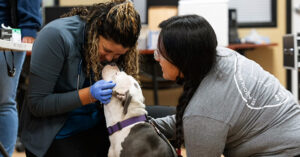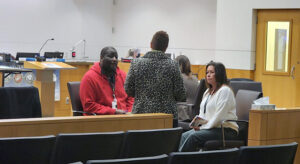In the fourth episode of our Community Collaborative Series, we dig deeper into the conversation surrounding diversity and inclusion. This episode is packed with thought-provoking commentary and eye-opening experiences as our community leaders dive into the idea of living our labels.
They also provide insights as to what institutions and organizations can do to better address issues of diversity and equity, making suggestions for how to be more authentic in their approach and delivery.
This week, Community Collaborative co-host/producer and Black Chamber of Arizona CEO Robin Reed is joined by co-host/producer and Arizona Hispanic Chamber of Commerce CEO Monica Villalobos to lead the discussion on the limitations and misrepresentations of labels when it comes to diversity and inclusion.
Joining Reed and Villalobos on this episode are Tim Overton, diversity and inclusion expert and appointed member of the Arizona Commission of African American Affairs and Simone Bayfield, MBA Candidate at the W.P. Carey School of Business at ASU.
Reed opens the episode by exploring how labels influence the way we view others and the world around us. Becoming conditioned to these labels can lead to misunderstandings and have implications when it comes to diversity and inclusion efforts. Reed was reminded of this in a conversation with Simone Bayfield as she discussed the diversity of her MBA program.
Bayfield shared with Reed that she is the only African American in her MBA program, but she is not the only Black student. The MBA program has international students from Africa who are often grouped under the same diversity label as Bayfield. This type of misrepresentation is recognized as false diversity.
With this in mind, Reed, Villalobos, Overton and Bayfield explore essential questions all institutions and organizations should consider when evaluating their approach to and display of diversity and inclusion:
- How can institutions and corporations work to avoid creating false diversity?
- How can institutions and organizations improve the pipeline to ensure more accurately represented diversity that includes domestic minorities?
- How can institutions and organizations engage in more authentic approaches to diversity and inclusion?
Don't Miss These Highlights
Bayfield shares her experience at the W.P Carey school of business at ASU. As the only African American student in her MBA program, she mentions how she feels like “a community of one” (5:40).
Bayfield expresses her concern that educational institutions rely on international students for diversity, failing to recognize the needs of domestic minorities. The problem, she notes, is that sharing a skin color does not equate to sharing a reality (9:02).
Compared to her Black international classmates, she explains, “it’s very different growing up being Black in America where you are very clearly the minority and your heritage and culture… you don’t have these things to be prideful in” (6:24).
She draws attention to how misleading diversity statistics are when they are dependent on international students, highlighting the need for improving the pipeline to diversity in order to address current problems of equity and diversity representation (21:31).
Monica Villalobos shares her fear that educational institutions are shaping the understanding and definition of diversity and inclusion in the business world (10:55). She explains how this approach targets quotas, not the inclusivity of diverse populations.
Villalobos suggests a top-down leadership approach to help clearly define what diversity really is and how it is applied to programs and organizations (12:14). This clarification is imperative to avoiding false diversity.
Tim Overton agrees with the danger of bringing people in for the purpose of meeting the “need for diversity” (13:50). He encourages companies to look beyond the need to check the box so they can begin to truly benefit from the diversity of thought and experience.
Overton urges leaders to involve everyone in finding solutions, empowering them to take responsibility to move forward (27:47). Overton reiterates that having a plan and being authentic with the implementation is essential to progress (38:21).
Bayfield closes by offering insights from a potential employee. She expresses the importance of going beyond the generic statements and photos on a website, reminding us that it is about what is being done to make advancements in diversity and inclusion that matters(30:03).
Actions Organizations Should Take
Important actionable takeaways from Episode 4 include:
- – Rather than relying on international applicants, include domestic minorities when considering diversity.
- – Pay attention to the labels given to employees. Prevent people from becoming their label, serving no other purpose than adding a diverse name to the roster (14:11).
- – Practice top-down buy-in (18:33).
- – Incentivize diversity and inclusion efforts, understanding that people will change once diversity is a compensable measurement (20:20).
- – Engage in difficult conversations revolving around diversity to improve educational programs and organizations (27:31).
- Take a look at your numbers. Consider the picture of diversity and inclusion they paint, ensuring they are not representing false diversity.
- – Establish and highlight diversity across all levels of employees, including C suite and executive levels where you can (31:16).
- – Show your commitment to diversity and inclusion beyond the walls of your business. Get involved in the community, helping diverse populations within the area.
- – Review the resources you are providing to your minority populations. Improve the resources by inquiring about the experiences the minority populations are having.
- – Review how assets are allocated. People, including prospective employees, look toward money trails to inform them of how committed an organization is to diversity (33:54).
- – Publish honest diversity numbers to help take the pressure off of the diverse candidates to ask these difficult questions. Make the information more public knowledge to show the commitment of the company (34:36).
- – Be authentic in wanting to make progress (39:03).
- – Be willing to ask questions. Ask employees and candidates about their thoughts and experiences. Progress will pick up the pace when we ask honest questions and receive honest answers (41:42).
While the landscape of diversity and inclusion includes major strides in recent decades, the discussion from today’s Community Collaborative reminds us that the conversation is ever-changing and the work is far from over.
While the goal remains to make diversity and inclusion efforts part of an organization’s DNA, it is essential to understand the dangers of false diversity and the implications false diversity has for the leaders of tomorrow. As this episode reminds us, progress will find its way once we approach issues surrounding diversity and inclusion with honesty and authenticity.
About The Community Collaborative
Community and business leaders and individuals who want to educate themselves on diversity issues will find the series informative and educational. And anyone who wishes to get involved will have ready access to resources featured in each program.
The video series may be streamed for free through the STN app. Viewers may subscribe through STN’s website or by downloading the STN app on the App Store or Google Play.
Each program in the series will provide details on how to get involved in featured activities and initiatives. To be featured in “The Community Collaborative” series or other STN programming, contact us at 480.967.7088.
Every day, there are leaders on the front lines of the fight to improve life in our community. STN provides the platform to tell their and their communities’ stories with video series on leadership philosophies and active efforts to make positive change in our region.





